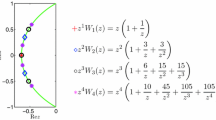Abstract
The complete electromagnetic responses from conducting objects in time and frequency domains are generated by using their early time and low frequency information. Utilizing two kinds of Hermite polynomials and their Fourier transform, the time-domain signal and its corresponding frequency response can be expressed as a weighted sum of these quantities in an efficient way. The general properties of these two families of Hermite functions are studied, which greatly affect the performance of the proposed method. Due to the performance of the algorithm being sensitive to the choice of the origin and the scaling factor, how to properly choose the initial values of these parameters is considered. An optimal algorithm is also developed to find the above parameters so as to achieve the best performance. A criterion is also provided to assess the sensitivity of the performance. The excellent agreement between the computed results by the proposed method and those obtained by earlier approaches is demonstrated in each case.











Similar content being viewed by others
References
F. M. Tesche, On the analysis of scattering and antenna problems using the singularity expansion technique. IEEE Trans. Antennas Propagat. 21, 53–62 (1973) Jan.
D. L. Moffatt, and R. K. Mains, Detection and discrimination of radar target. IEEE Trans. Antennas Propagat. 23, 358–367 (1975) May.
L. B. Felsen, Transient electromagnetic fields. (New York, 1976).
D. M. Pozar, Y. W. Kang, D. H. Schaubert, and R. E. Mcintosh, Optimization of the transient radiation from a dipole array. IEEE Trans. Antennas Propagat. 33, 69–75 (1985) Jan.
Y. W. Kang, and D. M. Pozar, Optimization of pulse radiation from dipole arrays for maximum energy in a specified time interval. IEEE Trans. Antennas Propagat. 34, 1383–1390 (1986) Dec.
K. S. Yee, Numerical solution of initial boundary value problems involving Maxwell’s equations in isotropic media. IEEE Trans. Antennas Propagat. 14, 302–307 (1966) May.
S. M. Rao, and D. R.Wilton, Transient scattering by conducting surfaces of arbitrary shape. IEEE Trans. Antennas Propagat. 39, 56–61 (1991).
D. A. Vechinski, and S. M. Rao, A stable procedure to calculate the transient scattering by conducting surfaces of arbitrary shape. IEEE Trans. Antennas Propagat. 40, 661–665, (1992) June.
R. F. Harringtion, Field computation by moment methods. (Macmillan, New York, 1968).
A. Sadigh, and E. Arvas, Treating the instability in matching-on-in-time method from a different perspective. IEEE Trans., Antennas Propag. 41(12), 1695–1702 (1993) Dec.
B. P. Rynne, and P. D. Smith, Stability of time marching algorithms for the electric field integral equation. J. Electromagn. Waves Appl. 4, 1181–1205 (1990) Dec.
J. L. Hu, et al., An improved temporal basis function for the time domain electric field integral equation method. Electron. Lett. 35(11), 883–884 (1999) May.
M. M. Rao, T. K. Sarkar, T. Anjali, and R. S. Adve, Simultaneous extrapolation in time and frequency domains using Hermite expansions. IEEE Trans. Antennas Propagat. 47, 1108–1115 (1999) June.
M. M. Rao, T. K. Sarkar, R. S. Adve, and T. Anjali, Extrapolation of electromagnetic responses from conducting objects in time and frequency domains. IEEE Trans. Antennas Propagat. 47, 1964–1973 (1999) Oct.
L. E. Scales, Introduction to non-linear optimization. (Macmillan, London, 1985).
M. Abramowitz, and I. Stegun, Handbook of Mathematical Functions. (Dover, New York, 1965).
J. B. Martens, The Hermite transform-theory. IEEE Trans. Acoust. Speech. Signal Processing. 38, 1595–1606 (1990) Sep.
S. M. Rao, D. R.Wilton, and A. W.Glisson, Electromagnetic scattering by surfaces of arbitrary shape. IEEE Trans. Antennas Propagat. 30(3), 409–418 (1982) May.
Author information
Authors and Affiliations
Corresponding author
Additional information
This work was supported in part by natinal nature science foundatin of China (NO. 60432040).
Rights and permissions
About this article
Cite this article
Jiang, G., Zhu, H. & Cao, W. On Extrapolation of Electromagnetic Responses in Time and Frequency Domains. Int J Infrared Milli Waves 28, 677–688 (2007). https://doi.org/10.1007/s10762-007-9245-5
Received:
Accepted:
Published:
Issue Date:
DOI: https://doi.org/10.1007/s10762-007-9245-5




